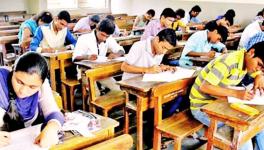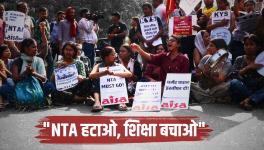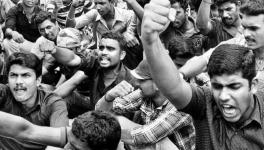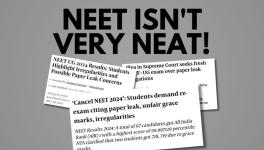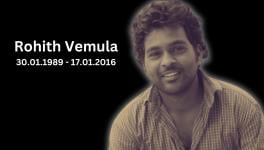Anitha is Killed by Modi’s Homogenising Obsession
-S. Anitha
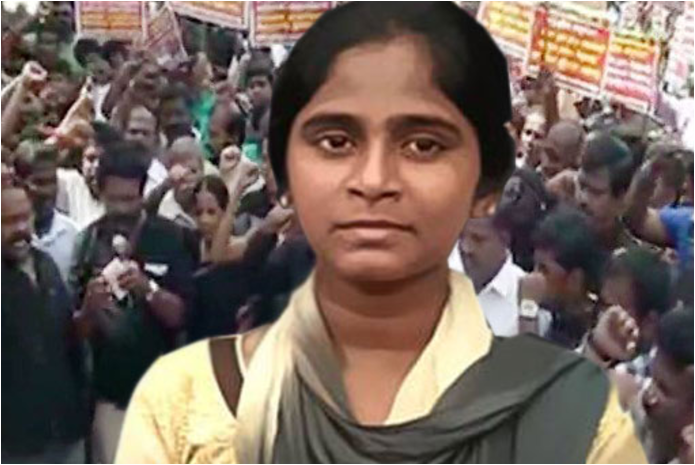
“When nobody gets equal opportunity, who are they deceiving by saying single exam for all…?”
-S. Anitha
Anitha, a 17-year-old dalit girl from Kuzhumur village in Ariyalur district, Tamil Nadu, daughter of a daily labourer in Trichy’s Gandhi market, committed suicide at her home on 1 September. Unlike Rohith Vemula, she has not left a suicide note for the shameless establishment to take advantage of, and claim that she has not blamed anyone. Anitha has made an eloquent statement by her silence; and in doing so, blamed the neoliberal-hindutva agenda being pushed forth by the Modi government. What is left behind is her video clip asking for help in fulfilling her legitimate ambition of becoming a doctor. She urged everyone to notice how she worked hard for it, scoring 98% marks in her plus-two exam, and standing first in the school. But she apprehended that her father’s poor financial condition may come in the way of her higher studies. Anitha, like Rohith, represents the plight of the dalit students in this country and shames India with her death.
Who killed Anitha? In the face of it, her failure to qualify in the NEET examination, and consequently, in getting a seat in the medical college caused her death. What is this NEET — National Eligibility and Entrance Test? Like any other anti-people policy, this one was also born during the Congress regime. The announcement to introduce NEET-UG in 2012 came from the Medical Council of India. This announcement was opposed by several states including Andhra Pradesh, Karnataka, Gujarat, West Bengal and Tamil Nadu, stating that there was a huge difference in the syllabus proposed by the MCI and the state syllabi. Initially, the NEET was conducted in two languages: English and Hindi. But this language bias was later resolved, and nine more languages were included for the 2017 examination.
NEET was declared illegal and unconstitutional by the Supreme Court of India in 2013. However, it was restored on 11 April 2016, after a five-judge Constitution bench recalled the earlier verdict, and allowed the Central Government and the Medical Council of India (MCI) to implement the common entrance test until the court decides to take a fresh decision regarding its validity. It is this NEET that failed Anitha and led her to kill herself.
The NEET, it may be understood, is a part of the neoliberal reforms, first started by the Congress government, but now being zealously pushed by the present dispensation under Modi. There is a qualitative difference between the Congress and the BJP: While the Congress has also served the capitalist class by virtue of its composition of a broad spectrum of ideologies right of the centre, it tried to strike a balance between them, and thereby, made them durable. But the BJP is ideologically homogenous and represents the extreme right, working towards a specific goal of building a Hindu Rashtra while relying on fascist methods for policy implementations. Therefore, it does not have any qualms, and presents itself as far more decisive than the Congress. Homogenisation of every sphere of the country is informed by its ideal: One nation, one language, one leader, one people akin to ein reich, ein volk, ein fuhrer of the Nazis. This is intrinsically unconstitutional because it is against the diversity of India under the federal structure mandated by the Constitution. But who would challenge them? The NEET is formalised and implemented by the same fascist regime.
Is the NEET justified? The NEET is justified on the grounds that it will eliminate admission-related corruption in private institutions, and will provide relief to students giving multiple entrance tests; lessen corruption in the admission tests due to the supervision of MCI and CBSE and, finally, drive towards a common syllabus. All of this is assumed to be desirable. Consequently, it assumes that it will ensure that the same standard of physicians is produced all over India. It does not realise the mess created between input and output in such an assumption; an entrance exam does not determine the standards of the doctors who have passed out, unless the process, their education is also standardised.
Similar things can be said about each of the arguments proffered in its justification. For instance, most major states have their own state medical entrance exams. States like West Bengal and others have nearly four decades of experience in organising medical entrance exams. Is there any evidence of corruption there? It is a question of private medical colleges charging capitation fees for the seats in management quota. Who asked them to start these private colleges in the first place? If they indulge in corruption, they can be closed down or can be taken over by the state. In any case, the problem of capitation fee is the problem of the upper-middle class and the super rich, and should not influence the common policy of the government. The simple solution to this problem would have been to admit students through already existing state medical entrance exams.
There are many students who might be seeking admission in other state medical colleges and have to, therefore, take multiple exams. Generally, students take their domicile state’s exam, try getting admission in more prestigious central institutions and appear for their exam, and then, when all the options are exhausted, they appear for the examinations conducted by private colleges. In any case, the central medical institutes like AIMS, JIPMER, etc., have been excluded from the NEET. Hence, students will anyway appear for examinations a second time despite NEET. Then what is the argument? Without any evidence of which exams are being eliminated by the NEET, they have implemented it.
The common syllabus aimed at by the NEET is disconnected from the reality of school education in India. The NEET is based on the CBSE syllabus. The CBSE exists in the major towns and cities of India, started primarily for transferable central government employees. It stands as a minority among the state boards. Maharashtra state board alone has more Class XII students than the total strength of CBSE students all over India. Why, the question arises, is this minority consideration allowed to override the vast majority? With regards to the standards, do they imply that the standard of science in the CBSE syllabus is superior to that of the state boards? Again, there is no evidence. Rather, the evidence is the contrary: A rigorous study published in Current Science, 2009, shows that, in terms of science-proficiency of students, some of the state boards like West Bengal and Andhra Pradesh have done much better in all science subjects than CBSE. But when the NEET exam was conducted in 2013, both these states underperformed. Maharashtra may not have the best science education, but cannot be dismissed as the worst either, as the NEET results had indicated. The Delhi-based CBSE board syllabus is being imposed as the best. Scores of students from the state boards like Anitha are placed at a disadvantage because of this unreasonable policy of the NEET.
What is more damaging is that the NEET is discriminatory towards students from rural areas; the urban poor and those belonging to the lower strata of the society. The CBSE being urban-centric completely excludes the rural areas. The devaluation of the Class XII exams gives rise to coaching classes. The institutionalisation of entrance exams at the state level has resulted in the mushrooming of coaching shops, resulting, in turn, in the marginalisation of school education. The students don’t attend classes in the eleventh and twelfth standards. As a result, they merely comply with, and sometimes barely meet the minimum requirements for sitting in the exams to pass.
In the state level exams, for which the syllabus is the same for all, poor students who cannot afford expensive coaching classes can also hope to take the exams and perform as well as those who attend coaching classes. But in the NEET, their training and hard work is compromised. As it has already happened with the IIT-JEE (Kota being the hub of IIT-JEE coaching), this centralised exam will directly lead to more coaching centers.
The government has already offered higher education to WTO-GATS. This was done for the first time under the BJP-led NDA government of Atal Bihari Vajpayee, and a second time in 2005, under Manmohan Singh. Once the current Doha Development Round is concluded, this offer will become an irrevocable commitment; and the higher education sector of India will have to be thrown open to international traders’ in higher education. All subsidies, a plethora of reservations, scholarships, and all social justice measures that characterised the education sector in India would go away, as they may be termed barriers to free trade. There was a strong apprehension about the conclusion of this round at the Tenth Ministerial Conference of the World Trade Organisation held at Nairobi, Kenya in December 2015. Fortunately, it did not conclude. But we must remain aware of, and alert to the fact that the Indian government, through its so-called education reforms, has been preparing itself to adopt the GATS agenda in education. These include the four-year undergraduate program (FYUP), the choice-based credit system, the cutting down of the non-National Eligibility Test (non-NET) fellowships, and research funding. All of this has been met with fierce opposition from the student community and educationists, but the government has haughtily ignored it so far.
Poor Anitha is the victim of this neoliberal-hindutva agenda of the government.
Disclaimer: The views expressed here are the author's personal views, and do not necessarily represent the views of Newsclick.
Get the latest reports & analysis with people's perspective on Protests, movements & deep analytical videos, discussions of the current affairs in your Telegram app. Subscribe to NewsClick's Telegram channel & get Real-Time updates on stories, as they get published on our website.









